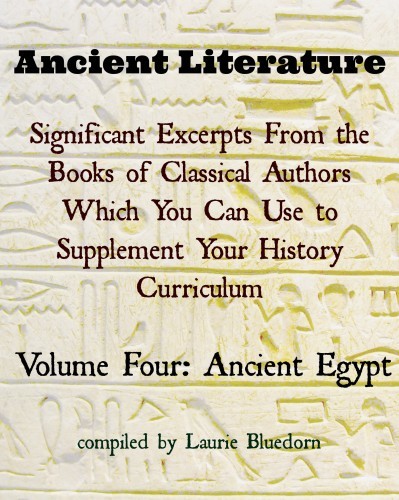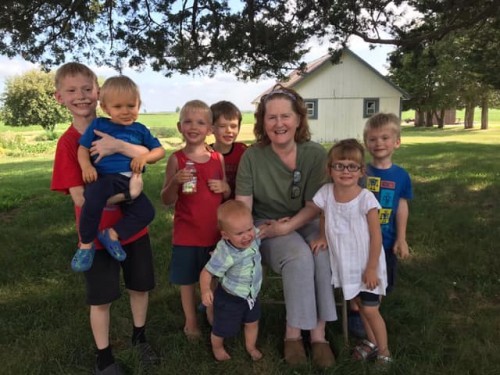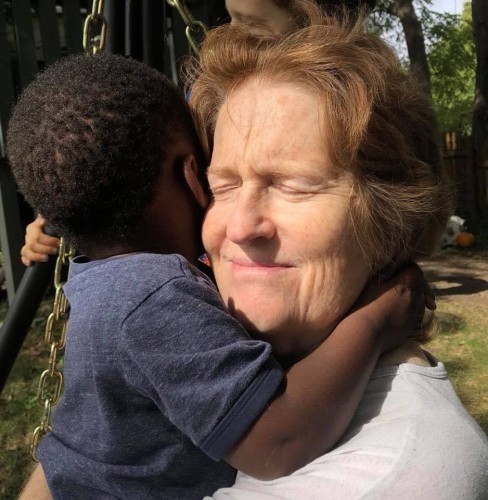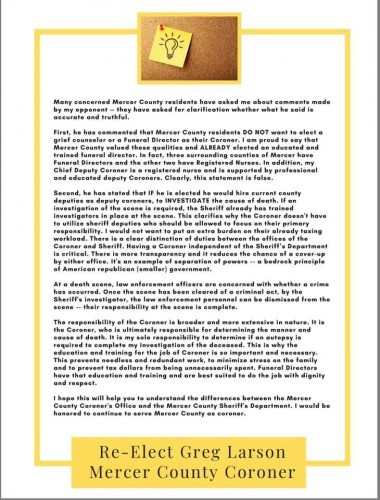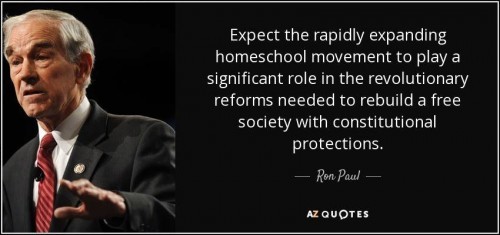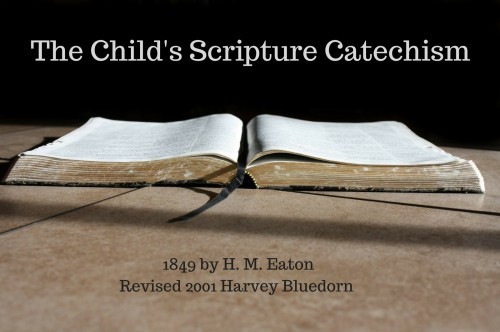Laurie Bluedorn's Blog, page 2
February 26, 2020
Free — Ancient Literature — Significant Excerpts From the Books of Classical Authors Which You Can Use to Supplement Your History Curriculum Volume Four: Ancient Egypt
Use primary sources to enhance your study of ancient history.
This 130-page ebook can be used to supplement any ancient history curriculum and is suitable for ages ten through adult. For this volume, we combed through the books of 32 ancient authors to find 78 significant excerpts concerning the time period from The Tower of Babel to 30 B.C. We then arranged the excerpts chronologically and provided the text and citation for each.
Today, we are giving away this ebook. You can download it here.
Contents of Ebook
Moses — NAME OF AUTHOR
Bible: Genesis — NAME OF BOOK
The Tower of Babel — DESCRIPTION OF SIGNIFICANT EXCERPT
Josephus
Antiquities of the Jews
Where the children of Ham settled after the Tower of Babel
David
Bible: Psalm
Egypt was called the land of Ham or the land of Mizraim
Herodotus
The History
Min, first king of Egypt
Diodorus Siculus
Historical Library
Early history of Egypt
Diodorus Siculus
Historical Library
Cheops builds the pyramid
Herodotus
The History
The pyramids
The Instruction of Ptah-Hotep
Considered the oldest book in the world; a compilation of wise sayings; written c. 2450 B.C.
Letter of Pepi II
Letter of Egyptian pharaoh Pepi II (ruled 2161-2067 B.C.) to Harkhuf (an Egyptian official)
Moses
Bible: Genesis
Abram is called by God and travels to Canaan (c.1875 B.C.)
The Edwin Smith Surgical Papyrus
Earliest known surgical document; written around the 16th century B.C.
Epitaph of Beka
Inscription on a funeral pillar; Beka, the person who died, was the great steward of the Public Granary
The Laboring Classes
Compares the different occupations and their hardships with the easy occupation of a scribe
Moses
Bible: Genesis
Jacob is established in Egypt (c.1660 B.C.)
Herodotus
The History
Farm labor in Egypt is easy because of the Nile
Herodotus
The History
The people and customs of Egypt; embalming
Herodotus
The History
Egyptian crocodile and other animals
The Shipwrecked Sailor
A man tells of his fantastic adventure
Moses
Bible: Exodus
Moses leads the Israelites out of Egypt (c.1445 B.C.)
Justin
Epitome of the Philippic Histories
Roman view of the early history of the Jews and of the Exodus
Pliny the Elder
Natural History
Description of Egypt
Diodorus Siculus
Historical Library
Description of Egypt
Diodorus Siculus
Historical Library
How the pharaohs lived
Diodorus Siculus
Historical Library
Customs of the early Egyptians
Diodorus Siculus
Historical Library
Egyptian medicine
Products of Arabia
Inscriptions on the inner walls of an Egyptian temple giving an account of the conquest of Arabia during the time of Thutmose III (ruled c. 1138-1085 B.C.)
Jeremiah
Bible: I Kings
David reigns over Israel (c. 1010-970 B.C.)
El-Amarna Letters
Tablets of Tel El-Amarna; Palestine is under Egyptian rule and the governor of Jerusalem (plus other Egyptian rulers in Palestine) tells pharaoh Akhenaten (ruled c. 1022-1006 B.C.) of a general revolt of the natives
Jeremiah
Bible: I Kings
The foundation of Solomon’s temple is laid (c. 966 B.C.)
Ramesses at Kadesh
Poem recording the battle between Pharaoh Ramesses II (ruled c. 940-873 B.C.) and the Hittite King Muwatallis II; called the Battle of Kadesh (c. 936 B.C.).
Treaty Between Ramesses II and the Hittites
A treaty of peace was signed between Ramesses II (ruled c. 940-873 B.C.) and the Hittite king after the battle called Kadesh (c. 936 B.C.)
The Mouse as Vizier
Ancient Egyptian Tale
Jeremiah
Bible: I Kings
The kingdom of Israel is divided; Rehoboam rules Judah (c. 930-913 B.C.) and Jeroboam rules Israel (c. 930-909 B.C.)
Jeremiah
Bible: I Kings
Ramesses II (the Great) — called Shishak in the Bible — sacks Jerusalem (c. 925 B.C.)
Spoliation of Tombs
Extract from a longer document from the time of Ramesses IX (ruled c. 835-816 B.C.) showing that tomb robbery was common even during ancient times
Strabo
Ancient Geography
Description of ancient Egypt
Sulpicius Severus
Sacred History
Hoshea makes an alliance with the Ethiopians, who at that time held Egypt (c. 726 B.C.)
Jeremiah
Bible: II Kings
Hoshea, the king of Israel, conspires with the king of Egypt/Ethiopia and stops paying tribute to the king of Assyria; Sargon of Assyria carries away the people of Israel (c. 722 B.C.); New Chronology says this king of Egypt/Ethiopia was Hedjkheperre Shoshenq Si-Bast (Shoshenq IV)
Isaiah
Bible: Isaiah
The prophet Isaiah predicts the war of Assyria against Egypt (c. 713 B.C.)
Josephus
Antiquities of the Jews
How Sennacherib made an expedition against Hezekiah (King of Judah); what threatenings Rabshakeh made to Hezekiah when Sennacherib was gone against the Egyptians; how Isaiah the prophet encouraged him; how Sennacherib having failed to success in Egypt, returned to Jerusalem; and how upon his finding his army destroyed, he returned home (c. 704-701 B.C.)
Ezra
Bible: II Chronicles
The Battle for Jerusalem (c. 704-701 B.C.)
Herodotus
The History
Herodotus’ report of the invasion of Egypt by Sennacherib
Diodorus Siculus
Historical Library
Civil disorder in Egypt for two years followed by a twelve-man aristocracy (c. 687-670 B.C.)
Herodotus
The History
The twelve-man aristocracy diverts the flow of the Nile
Herodotus
The Histories
Psammetichus Sais took over Egypt and reigned there 54 years (c. 670 B.C.)
Herodotus
The Histories
The son of Psammetichus Sais — Necho or Pharaohnecho — rules Egypt for 16 years (c. 616 B.C.)
Ezra
Bible II Chronicles
Pharaohnecho, king of Egypt, set out to fight against the king of Assyria/Babylon by besieging Carchemish on the Euphrates River; Josiah, King of Judah, interferes and is killed (c. 610 B.C.)
Jeremiah
Bible: II Kings
Another version of Josiah’s death (c. 610 B.C.)
Josephus
Antiquities of the Jews
How Josiah fought with Necho and was wounded and died; Josiah’s son Jehoahaz (Shallum) becomes king of Judah (c. 610 B.C.)
Josephus
Antiquities of the Jews
When Necho returned from Assyria, he deposed Shallum and made Eliakim (Jehoiakim), his older brother, king of Judah (c. 610 B.C.)
Jeremiah
Bible: II Kings
When Necho returned from Assyria, he deposed Shallum and made Eliakim (Jehoiakim), his older brother, king of Judah (c. 610 B.C.)
Jeremiah
Bible: Jeremiah
Jeremiah makes a prophecy that Nebuchadnezzar would conquer Egypt (c. 607 B.C.)
Jeremiah
Bible II Kings
Nebuchadnezzar took all the land between Egypt and the Euphrates River (c. 605 B.C.)
Herodotus
The Histories
Psammis rules Egypt for 6 years (c. 600-594 B.C. )and his son Apries (Pharaohhophra) rules for 25 years (c. 594-570 B.C.)
Ezekiel
Bible: Ezekiel
Ezekiel makes a prophecy about Apries (Pharaohhophra) (c. 588 B.C.)
Ezekiel
Bible: Ezekiel
Ezekiel makes another prophecy concerning Egypt (c. 587 B.C.)
Ezekiel
Bible: Ezekiel
More prophecy concerning Egypt (c. 587 B.C.)
Jeremiah
Bible: Jeremiah
Pharaohhophra came with his army from Egypt to help Zedekiah, king of Judah, while the Chaldeans were raising a siege of Jerusalem (c. 587 B.C.)
Jeremiah
Bible: Jeremiah
Jerusalem is taken by the Chaldeans/Babylonians (c. 586 B.C.)
Jeremiah
Bible: Jeremiah
The remnant of the Israelites force Jeremiah to go with them to Egypt; Jeremiah predicts the destruction of Egypt by Nebuchadnezzar (which occurred c. 571 B.C.) and makes a prophecy about Apries (Pharaohhophra) (c. 586 B.C.)
Ezekiel
Bible: Ezekiel
Ezekiel’s prophesy against Egypt (c. 586 B.C.)
Sulpicius Severus
Sacred History
The remnant Jews flee to Egypt (c. 586 B.C.)
Diodorus Siculus
Historical Library
Apries (Pharaohhophra) rules Egypt (c. 594-570 B.C.) and after him, Amasis, his son, rules while paying tribute to the Babylonians (c. 570-525 B.C.)
Herodotus
The Histories
Cambyses, son of Cyrus, conquers Egypt (c. 525 B.C.)
Arrian
Anabasis of Alexander
Alexander the Great conquers Egypt (332 B.C.)
Diodorus Siculus
Historical Library
Alexander the Great conquers Egypt and founds Alexandria (332 B.C.)
Vitruvius
On Architecture
How Alexander chose the man who designed Alexandria (332. B.C.)
Josephus
The War of the Jews
Alexander the Great moved a colony of the Jews (along with other groups of people) to Alexandria in order to populate it (331 B.C.)
Arrian
Anabasis of Alexander
Alexander settles affairs in Egypt before leaving (331 B.C.)
Lucian
Octogenarians
After the death of Alexander the Great, all of Egypt, among other lands, was given to Ptolemy (323 B.C.)
Daniel
Bible: Daniel
Daniel tells (200 years earlier) of Alexander the Great and what happens at his death
Justin
Epitome of the Philippic Histories
Ptolemy takes over Egypt and wins over the people
Diodorus Siculus
Historical Library
Ptolemy brings the body of Alexander the Great to Egypt to bury (321 B.C.)
Josephus
Antiquities of the Jews
How Ptolemy took Jerusalem and transported many Jews to Alexandria (320 B.C.)
Vitruvius
On Architecture
Ptolemy Philadelphus establishes a library at Alexandria (277 B.C.)
Tertullian
Apology
Ptolemy Philadelphus calls for a Greek translation of the Hebrew scriptures (277 B.C.)
Josephus
Antiquities of the Jews
Ptolemy Philadelphus calls for a Greek translation of the Hebrew scriptures (277 B.C.)
Plutarch
The Lives of the Noble Grecians and Romans: Antony
The Ptolemys rule Egypt until the death of Cleopatra in 30 B.C.; Egypt becomes a Roman province
Also available in this series:
Volume One: Julius Caesar
Volume Two: Alexander the Great
Volume Three: Augustus, Jesus Christ, and Tiberius
Volume Four: Ancient Egypt
Volume Five: Caligula, Claudius, and Paul
Volume Six: Nero, Paul, and the Destruction of Jerusalem
More on the Ovarian Cancer Journey

Me and oldest Grand — will he remember this moment in time?

Avastin infusion is green today — they’re trying to change my DNA to that of a Martian.
We are having some difficulties. If you would like to help us, I would be grateful.
The Mercer County Conservative
Mercer County Conservative
Conscience and Common Sense
On the Separation of Powers: “…I say, that Power must never be trusted without a check.” ―John Adams
■ National News
PRESIDENT TRUMP
Don Jr. and Don Sr. and the WWII Vet
In a little over three years, Donald Trump has nominated and won Senate confirmation for 192 federal judges.
Donald Trump is appointing federal judges at a blistering pace — by the end of his first term, a quarter of them could be his choices
BLOOMBERG
Bloomberg on why farmers can’t work in information technology MB: “I can teach anyone how to be a farmer. 1 dig a hole; 2 put a seed in; 3 put dirt on top; 4 add water; 5 up comes the corn.” The skill 4 information technology is completely different — you need more grey matter.
Bloomberg says healthcare will “bankrupt us” unless we deny care to the elderly. “If you show up with cancer & you’re 95 yrs old, we should say…there’s no cure, we can’t do anything.” Decrepit Mike will get treatment, the unwashed masses get nothing.
SANDERS
Bernie Sanders on the Soviet Union Press Conference 6/13/1988
Exclusive video: After returning from the Soviet Union BernieSanders says that he saw no deprivation and that people seemed happy. (Millions died from starvation)
BREAKING: Nicaraguan dictator Daniel Ortega takes a short break from killing children who protest his socialist dictatorship to endorse his old friend and advisor BernieSanders.
KLOBUCHAR
ICYMI: Amy Klobuchar says she wants to raise the “death tax” — that President Trump had previously cut.
‘Order at the border': Klobuchar demands illegal immigrants learn English in 2006 clip
BUTTIGIEG
Buttigieg vows to overturn ban on federal funding for abortions
Buttigieg promises health care to illegal immigrants if elected president
Buttigieg claims to be the only true Christian candidate
CORRUPTION
DHS Whistleblower against Obama Administration Philip Haney Found Dead – Shot and Killed
“K.T. McFarland Opens Up About Her Abuse at the Hands of Mueller’s Henchmen…suffice it so say, the rumors about how Mueller’s team operated are clearly true. These weren’t people looking for justice. These were people looking to deliver scalps in order to take down Trump, either directly or with the hope of creating a case for impeachment…”
This takes the cake. Order on Motion to Disqualify Judge — actual document in which Judge refuses to recuse herself from the case
Washington Post media columnist wants journalists to be harder on Trump. Comes up with catchy name for new approach: ‘Fairness First.’
PELOSI
Nancy Pelosi is Demanding Facebook and Twitter Remove This Video
ILHAN OMAR
Rep. Ilhan Omar’s ‘Reign of Terror’ to Suppress the Truth About Her Marriages
■ Mercer County News
Republican Candidates 2020 (primary is March 17)
County, State, National Candidates
— Mercer County Coroner Greg Larson
— Mercer County States Attorney Grace Simpson
— Mercer County Circuit Clerk — none
— IL-74th District State Representative Dan Swanson
— IL-37th State Senate District Win Stoller
— IL-17th District U. S. House of Representatives Esther King
— U.S. Senate Mark C. Curran, Tom Tarter, Peggy Hubbard, and Robert Marshall
— and, of course, Donald Trump for President.
Mercer County Board Candidates
–County Board District 1 – Rebecca Hawn — (District 1 includes Abingdon, Keithsburg, North Henderson, Ohio Grove, Suez and Mercer 6 Precincts.)
–County Board District 2 – none — (District 2 includes Rivoli, Greene, and Richland Grove 2 Precincts.)
–County Board District 3 — Linda Koepke –(District 3 includes Preemption 1, Preemption 2, Richland Grove 1, and Richland Grove 3 Precincts)
–County Board District 4 – Josh Frieden — (District 4 includes Duncan, Eliza, Millersburg, New Boston, and Perryton Precincts.)
–County Board District 5 – none — (District 5 includes Mercer 1, 2, 3, 4, and 5 Precincts.)
Precinct Committeemen Candidates
North Henderson — Jo Anne Nelson
Rivoli
Richland Grove 1 — Buck Rind
Richland Grove 2
Richland Grove 3
Suez — Jeff Gregory
Greene 1
Greene 2 — Susan DeBlock
Preemption 1
Preemption 2
Ohio Grove
Mercer 1 — Barb Chiles
Mercer 2 — Linda Sarabasa
Mercer 3
Mercer 4
Mercer 5
Mercer 6 — Bob Vickrey
Perryton
Millersburg
Duncan
Keithsburg — Becky Hawn
New Boston — Harvey Bluedorn (write-in)
Eliza
Abington — Dusty Terrill
Important Dates for Mercer County
February 26 — On Wednesday, February 26 from 6:00-8:00 pm, our campaign office is open as we welcome Esther King, candidate for the Illinois 17th Congressional District. Come meet Esther as we support her run to get Cheri Bustos out of office. Our campaign office is at 604 SW 3rd Street, next to Dollar General.
July 10 — Mercer County Republican cash raffle. One ticket $10 — three tickets $20. Drawing is July 10th at our booth at the Mercer County Fair 5:30 pm. Need not be present to win. $3,000 worth of tickets will be sold.
■ Illinois State News
Illinois candidates to watch:
Jeanne Ives for Congress (IL-06)
Mary Miller for Congress (IL-15)
Esther King for Congress (IL-17)
■ Education
Such a perfect, concise encapsulation of years of education funding stories. It goes like this: “How to spend frivolously while simultaneously convincing the public for more money? Starve some budget items the parents care about — they’ll assume taxes simply have to rise.”
Maryland High School History Lesson Compares Trump With Nazis, Communists
■ Words to Brighten Your February
• façade = NOUN the front of a building; any face of a building given special architectural treatment; a false, superficial, or artificial appearance or effect
• garish = ADJ clothed in vivid colors; excessively or disturbingly vivid; offensively or distressingly bright, glaring; tastelessly showy, flashy
• malarkey = NOUN insincere or foolish talk, nonsense
Maintain Liberty — Learn Logic
Things to consider concerning screen time:
— Gray Matters: Too Much Screen Time Damages the Brain — Neuroimaging research shows excessive screen time damages the brain — “Taken together, [studies show] internet addiction is associated with structural and functional changes in brain regions involving emotional processing, executive attention, decision making, and cognitive control.”
— “As most parents of small children will reluctantly admit, nothing can occupy a child quite like television. Unfortunately, the scientific evidence suggests that using the boob tube as a babysitter has its price: the more time babies spend sitting in front of the screen, the more their social, cognitive and language development may suffer. Recent studies show that TV-viewing tends to decrease babies’ likelihood of learning new words, talking, playing and otherwise interacting with others….”
Subscribe to This E-Letter
If you know of others who would like to receive The Mercer County Conservative, send them this link.
February 16, 2020
The Little Red Lighthouse and the Great Gray Bridge
[image error] [image error]
The Little Red Lighthouse and the Great Gray Bridge[image error] by Hildegarde Swift, illustrated by Lynd Ward
Publication date 1942
This is the story about a lighthouse that stands near the George Washington Bridge in New York City.
On the bank of the Hudson River, a small red lighthouse protects boats with his beam and foghorn. One day, some workers arrive and start to build a gigantic steel bridge with huge flashing lights. The little red lighthouse feels afraid and wonders if he will ever be useful again. During one dark night, a violent storm threatens the safety of the boats on the river, and the role of the little lighthouse is revealed.
This part ALWAYS makes me cry:
“Then the great gray bridge talked to the little red lighthouse:
“Little brother, where is your light”
“Am I brother of yours, bridge?” wondered the lighthouse. “Your light was so bright that I thought mine was needed no more.”
“I call to the airplanes,” cried the bridge, “I flash to the ships of the air. But you are still master of the river. Quick, let your light shine again. Each to his own place, little brother!”
So the little red lighthouse tried to shine once more, but though it tried and tried and tried, it could not turn itself on.”
Teaching point of the story: even the small are important.
You can see the filmography story here.
Post may contain affiliate links to materials I recommend. Read my full disclosure statement.
February 6, 2020
More Portuguese Language Articles
A Transformação da Educação Clássica
Publicado por Joabe De Juda
O que é Educação Clássica?
Educação Clássica é ler Homero e Platão, ou César e Cícero? Muitos educadores clássicos diriam que sim – ler tal literatura é uma parte essencial de uma educação clássica. Mas, será que um foco desenfreado em literatura clássica (Grega e Romana) nos leva a Cristo?
Nós definimos uma Educação Clássica de modo diferente. Nós seguimos um modelo e método clássico de educação (chamado de O Trivium), mas o nosso interesse na literatura humanista clássica é apenas eventual. Não queremos seguir estas três ferramentas de aprendizagem (idiomas clássicos, habilidade no pensar e habilidade na comunicação) de modo que possamos realmente ler como Homero, pensar como Aristóteles e falar como Demóstenes. Como Cristãos, queremos aprender idiomas, lógica e retórica de forma que possamos realmente ler, pensar e falar – ponto final! Queremos dominar estas proveitosas ferramentas, mas não queremos utilizá-las como os antigos Gregos e Romanos faziam. Eles utilizavam essas ferramentas para servir a tudo, exceto ao Deus vivo e verdadeiro. Os Gregos e Romanos pegaram estas ferramentas e as usaram para seguir seus próprios propósitos. Nós apenas estamos reivindicando o que é, por direito, a herança dos piedosos, limpando-a e devolvendo-a para servir a nosso Senhor. As Escrituras contêm tudo o que precisamos para testar toda palavra humana e reter o que for resgatável para uso piedoso. Antes de poder utilizar qualquer coisa – incluindo literatura clássica – devemos coar através da peneira crítica das Escrituras……
O Trivium em uma Cápsula
Por Harvey e Laurie Bluedorn. Copyright 2002. Todos os direitos reservados
Traduzido por Joabe de Judá Carvalho
O Trivium consiste nas três primeiras disciplinas formais das sete artes liberais: Gramática, Lógica e Retórica. Este é o Trivium formal no sentido clássico. O Trivium formal é uma reflexão acadêmica do, ainda mais básico, Trivium Bíblico: as capacidades mentais do Conhecimento, Entendimento e Sabedoria (* Veja a lista de referências bíblicas ao final deste artigo). O estilo clássico de educação é baseado nestas três capacidades mentais ou intelectuais:
Primeiro: receber e reunir informação – Conhecimento;
Segundo: organizar e conectar a informação em uma ordem lógica – Entendimento;
Terceiro: colocar essa informação reunida e ordenada dentro de uma expressão prática – Sabedoria.
Crianças estão continuamente se desenvolvendo no Conhecimento, Entendimento e Sabedoria. Apesar destas três capacidades serem mutuamente dependentes umas das outras e elas se desenvolverem na criança desde antes do nascimento, todavia as crianças atravessam diversas etapas de desenvolvimento ou níveis de aprendizagem, onde uma capacidade se destaca dentre as outras. Descreveremos estas etapas abaixo. Tenha em mente que nossa divisão etária não se dispões a ser a única possível. São apenas aproximações arbitrárias e podem variar bastante de criança para criança.
O Nível de Conhecimento (ou Fase da Gramática): antes do nascimento até os 12 anos
A criança está sempre aprendendo fatos, relacionando-os entre si e expressando estes fatos e relações de maneira prática. Mas existe, no entanto, uma ordem lógica e de desenvolvimento entre eles. Durante os primeiros anos (até os 10 anos), a criança está massivamente aprendendo a linguagem, construindo seu vocabulário e preenchendo sua compreensão básica do mundo. Essas crianças precisam de mais treinamento do que de ensino. Elas devem ser treinadas para terem autodisciplina e serem preenchidas com informação proveitosa. Isso estabelece uma base adequada para estudos mais formais posteriormente. Enquanto todas as três capacidades estão se desenvolvendo com o passar do tempo, a capacidade de Conhecimento cresce com mais destaque. Chamamos este período de intensa aprendizagem de fatos básicos de Nível de Conhecimento Inicial porque ele estabelece a base para o que vem adiante, que é o período mais intenso de construção do Conhecimento.
Por volta dos 9 ou 10 anos, estas crianças desenvolvem a capacidade de pensamento de modo mais abstrato. Elas alcançaram tal estado de maturidade que a lâmpada se acende e sua capacidade de Conhecimento se torna uma onda crescente dentro de um intenso período, onde a capacidade e a habilidade de estudo acadêmico formal de conteúdos relacionados ao Conhecimento são mais produtivas. Elas conseguem lidar com conceitos matemáticos abstratos. Conseguem discernir a diferença entre um substantivo e um verbo. Isto pode ser chamado de Nível de Conhecimento Final. As habilidades de Entendimento (raciocínio) estão começando a aumentar o seu ritmo de desenvolvimento neste nível, deste modo alguns classificam isso como o início do Nível de Entendimento. Mas isso é, de fato, apenas um período de aquecimento. Suas habilidades de Conhecimento devem se tornar cada vez mais desenvolvidas antes que as habilidades de Entendimento (raciocínio) ou Sabedoria (expressão prática) possam se desenvolver de forma mais rápida.
Enquanto a criança está no Nível de Conhecimento, focamos em ensiná-la as habilidades de compreensão, de receber informação com precisão, de reunir os fatos. O Conhecimento é transmitido através de narração e demonstração. Ele vem através dos sentidos. Desenvolvemos um vocabulário de fatos e regras. Neste nível, não necessitamos separar as matérias. Podemos combinar: 1) linguagem com literatura e belas-artes; 2) matemática com ciências naturais; e 3) história com geografia e estudos culturais. Nosso objetivo é desenvolver competência nas ferramentas de pesquisa: leitura, escuta, escrita, observação e medição.
O Nível de Entendimento (ou Fase da Lógica): dos 13 aos 15 anos
O intenso período de Conhecimento dura cerca de 3 anos e, quando acaba, o Conhecimento, é claro, continua a crescer e a se desenvolver, mas a capacidade de Entendimento, que vinha se desenvolvendo todo este tempo, emerge como o líder nesta corrida. Com uma ampla base de Conhecimento já alicerçada e o desenvolvimento do Entendimento chegando ao nível de maturidade, outra lâmpada se acende. A capacidade de Entendimento agora se torna uma onda crescente dentro de um período intenso, onde a capacidade e a habilidade de estudo acadêmico formal de conteúdos relacionados ao Entendimento são mais produtivas. Os jovens de 13 a 15 anos começam a desenvolver suas habilidades de raciocínio. Eles conseguem lidar com álgebra e geometria. Eles estão desenvolvendo o aparato crítico para o pensamento. Devem ser mais questionadores e analíticos. Suas mentes têm que ser treinadas para chegar a uma conclusão correta das coisas e para poder avaliar logicamente pressupostos e conclusões.
Quando a criança está neste nível, nós a ensinamos a habilidade de raciocinar, de criticamente questionar, analisar, avaliar e discernir causas, motivos, meios, propósitos, objetivos e efeitos, para examinar a teoria. O Entendimento é transmitido através de instrução, correção e exercícios. Desenvolvemos um vocabulário de relações, ordem e abstrações. Nosso ensino tornar-se-á mais sequencial e sistemático, separando os diferentes ramos de aprendizagem. Nosso objetivo é desenvolver competência nas ferramentas de investigação: análise, comparação e contraste.
O Nível de Sabedoria (ou Fase da Retórica): dos 16 aos 18 anos
O intenso período de Entendimento dura cerca de 3 anos e, quando acaba, o Entendimento, é claro, continua a crescer e a se desenvolver, mas a capacidade de Sabedoria, que vinha se desenvolvendo todo este tempo, emerge como o líder nesta corrida. Quando uma ampla base de Conhecimento e Entendimento foi alicerçada e as desenvolventes partes da Sabedoria chegaram a um nível de maturidade, então a terceira lâmpada se acende. A capacidade de Sabedoria se torna uma onda crescente dentro de um período intenso, onde a capacidade e a habilidade de estudo acadêmico formal de conteúdos relacionados à Sabedoria são mais produtivas. Jovens mais velhos (de 16 a 18 anos) começam a desenvolver suas habilidades de comunicação e aplicação prática. Eles buscam expressar, de modo criativo e efetivo, as coisas que aprenderam e a colocar estas coisas em prática.
Quando a criança está neste nível, nós a ensinamos as habilidades de julgamento prudente e de se expressar efetivamente através da comunicação e aplicação prática. A Sabedoria é transmitida através do encorajamento à iniciativa individual e inovação, de fazer perguntas e de liderar debates. Desenvolvemos um vocabulário de ideias e valores filosóficos. Nós começamos a reagrupar o conhecimento e as habilidades de separar disciplinas. Buscamos a aplicação de princípios, valores e objetivos.
O intenso período de Sabedoria dura 2 ou 3 anos e, quando acaba, a Sabedoria, é claro, continua a crescer e a se desenvolver, mas todas as três capacidades (Conhecimento, Entendimento e Sabedoria) que vinham se desenvolvendo todo este tempo, emergem como um conjunto plenamente desenvolvido de ferramentas.
O Nível (ou Fase) Final de Acabamento: Dos 19 anos em diante
Durante os próximos dois anos, como todas as capacidades mentais foram plenamente desenvolvidas, a capacidade moral da consciência, que vinha se desenvolvendo todo este tempo, é trazida à sua completa capacidade. Jovens adultos de 19 a 20 anos devem trazer estas capacidades em harmonia debaixo da capacidade moral da consciência. A capacidade de assumir responsabilidade deve estar plenamente desenvolvida ao completar a maioridade bíblica de 20 anos (Números 14.29, etc.). Naturalmente, todas as capacidades continuarão a crescer, mas as ferramentas básicas que serão utilizadas no decorrer da vida devem estar todas desenvolvidas agora.
Aplicando o Trivium às matérias
Esta mesma progressão (Conhecimento, Entendimento, Sabedoria) se aplica a muitas outras coisas. Por exemplo, cada matéria individual de estudo tem três níveis de desenvolvimento. Primeiro nós aprendemos os fatos, que é o Conhecimento. Depois de sabermos uma quantidade considerável de fatos, começamos a descobrir a conexão entre eles, que é o Entendimento. E depois de sabermos uma quantidade considerável de conexões entre os fatos, criamos maneiras de se expressar e fazer aplicações dos fatos, que é a Sabedoria.
Disfunções
Se falharmos em desenvolver adequadamente uma capacidade ou, eventualmente, colocar todas as capacidades em equilíbrio, criaremos uma disfunção da aprendizagem. O Conhecimento é o mais básico de todos. Sem o Conhecimento de um assunto não podemos continuar a construir um Entendimento apropriado ou desenvolver Sabedoria no assunto. Da mesma forma, o desenvolvimento inadequado do Entendimento prejudicará a Sabedoria e, também, a capacidade de buscar o Conhecimento. Finalmente, um desenvolvimento inadequado da Sabedoria prejudicará a busca do Conhecimento e do Entendimento. Por exemplo, se falharmos em ensinar as habilidades fônicas básicas, iremos artificialmente causar a dislexia (inabilidade de ler bem). Se falharmos em ensinar as habilidades lógicas básicas, iremos artificialmente causar o que chamamos de dislogia (inabilidade de raciocinar bem). Se falharmos em ensinar as habilidades básicas de se expressar e de fazer aplicação prática, iremos artificialmente causar o que chamamos de dyssophia¹ (inabilidade de exercer um bom julgamento).
Resumo
Em resumo, as capacidades de Conhecimento, Entendimento e Sabedoria não são pequenos compartimentos bonitinhos com portas fechadas entre eles. Antes, todas elas se desenvolvem ao mesmo tempo bem desde o princípio, ainda que cada uma delas passem por sucessivos períodos de intenso desenvolvimento, até que elas finalmente se emparelhem umas às outras e trabalhem harmoniosamente juntas. Estas faixas etárias são apenas aproximadas e sua criança pode estar em ambos os lados da linha.
Para resumir tudo em uma única frase: Primeiro instruímos a criança no Conhecimento, depois orientamos o jovem no Entendimento, e depois desafiamos o jovem mais velho na Sabedoria.
* Êxodo 31.3; 35.31; 36.1; Deutoronômio 1.13,15; 1 Reis 7.14; Jó 15.8-9; Provérbios 2.6; 3.19,20; 5.1,2; 8.12; 18.15; 23.23; 24.3,4; Daniel 1.4,17; 5.14; Efésios 1.8,9,17,18; Colossenses 1.9,10; 2.2,3; e muitos outros lugares.
¹ Neologismo da língua inglesa sem termo correspondente em português. É formada do grego pelo prefixo dys (dificuldade; falta, privação, mau estado) e pela palavra sophía (sabedoria, saber, ciência).
January 26, 2020
Homeschool Voices From the Past — Raymond S. Moore
Excerpt from an interview with Raymond S. Moore in Human Events, September 15, 1984
Q: [Interviewer] I’m quoting you now: “An early start in formal institutionalized schooling deprives children of the free exploration so crucial to the development of genius.” Could you elaborate on that and give specific ways in which institutionalized learning may penalize or stifle genius?
A: [Raymond S. Moore] Harold McCurdy, a distinguished psychologist from the University of North Carolina and a leading student of genius, says that genius is derived from the experience of children being most of the time with adults and very little with their peers. So when you start assembling children in very large numbers for long periods of time, you are on the wrong course for producing strong character and intellect. The more children around your child, the fewer meaningful human contacts he will have.
Let me give you another example, the matter of adult responses. John Goodlad, Graduate Dean of Education at UCLA, came out with an article in the Phi Delta Kappan in March, 1983. He did a comparison of over a thousand schools and found that the average amount of time spent in person-to-person responses between teachers and students amounted to seven minutes a day.
I doesn’t take much to see that if your child is one of 20, 25, 30 or maybe more youngsters in a classroom and the teacher is giving only seven minutes a day in responses, that your child is lucky if he gets spoken to once a day. If he is an aggressive or misbehaving child, he might get more attention. But when a child is home with his mother, he may get one, two, three hundred answers to his questions and ideas a day. So you can see right there where we are in terms of the sheer potential there is for the stimulation of intellect in a home.
[image error][image error]
Home Grown Kids[image error] — one of the first books I read on homeschooling
Another reason why I like the Ron Paul Homeschool Curriculum
The Ron Paul Homeschool Curriculum is an academically rigorous college prep homeschool program, but it is also a practical program.
There are two parts to the Ron Paul Homeschool Curriculum:
–The academic
–The practical
Elsewhere we have discussed the academic part of the RPC. Today we will discuss the practical courses. These courses make up a supplemental program of hands-on, real-world courses that are not available in any other homeschool curriculum. All of the courses in the RPC offer the first five lessons for free. This shows parents and students what to expect from a course.
Here are the practical courses:
1. Personal Finance
This course teaches children the basics of money management. It teaches them why they need to save, how they need to save, and the best ways to save. To teach this course, Ron Paul hired Prof. Timothy Terrell, who teaches economics at the college level. This is a hands-on course relating to all aspects of setting goals, budgeting, and avoiding consumer debt. You know the lure of the credit card industry: “But you can have it now!” Your children will have the correct answer: “No, thanks. I’ll invest my money until I have enough to pay cash.” Maybe you have already begun to teach your children about money management. I hope you have. But I doubt that you will spend one hour a day, five days a week, for 36 weeks going through every aspect of money management. If you sign up your children for this course, you won’t have to. Because parents can take any courses that they buy for their children, you might want to take the course. This would be a great way to discuss money management with your children. I will tell you this: if your children take this course and follow its advice, they will never be in a desperate situation of massive debt of their own making. Take a look at the course here.
2. Business I — Introduction to Business. It is designed as a ninth-grade course. But any high school student can benefit from it.
Students who use this course have a unique opportunity to learn the basics of business: goal-setting, time-management, salesmanship, business ethics, business theory, direct-response copywriting — the key skill that almost no business owners possess — and how to set up a business for $100. This course is crucial for the Business II course, which takes students through the business-launch process. By the end of the 10th grade, a student who has taken both courses ought to have a profitable business — one that should generate a middle-class income by the time the student is 21. There is nothing remotely like these two courses in any high school curriculum.
3. Business II — Launch Your Business. This course is designed for tenth-graders yet any high school student can benefit from it. This course complements the lessons taught in the Business I course. If you’re a senior in high school I recommend you take both courses this year. There are three main objectives of the Business II course. You will…
–Learn about the world of business and online business opportunities.
–Develop valuable business skills including website development, graphic design, copywriting and eBook publishing.
–Plan and launch an online business which can generate a middle class income in 5 years.
4. Public Speaking
Students learn how to use rhetoric and logic to persuade people in a public setting. This skill pays off for a lifetime. There is a problem if your present curriculum is exclusively textbook-based. It is not possible to learn public speaking from a textbook. This is why some video-based courses are crucial for teaching public speaking. Think about what this would mean for your children. For the rest of their lives, they will not be afraid of standing in front of a group and presenting a position. They will think on their feet. There are so few people who can do this, that having this skill gives anyone an edge in his field, no matter what field this is. Most people are terrified of public speaking. This is a major barrier to advancement in every profession.
P.S. In addition to the above practical courses, Dr. Gary North teaches a free sample 46-lesson course on academic skills. Your children can take his course here.
Choose four Trivium Pursuit books if you order the Ron Paul Homeschool Curriculum.
Post may contain affiliate links to materials I recommend. Read my full disclosure statement.
January 21, 2020
Envy is the strongest of all emotions
Some say that envy is the strongest of all emotions.
Jealousy is when you admire something and wish you could be like that.
Envy is when you realize you can never be like that, so you want to destroy it.
Mark 15:10 For he knew that the chief priests had handed Him over because of envy.
James 3:16 For where envy and self-seeking exist, confusion and every evil thing are there.
Proverbs 27:4 Wrath is cruel and anger a torrent, but who is able to stand before envy?
Acts 13:45 But when the Jews saw the multitudes, they were filled with envy; and contradicting and blaspheming, they opposed the things spoken by Paul.
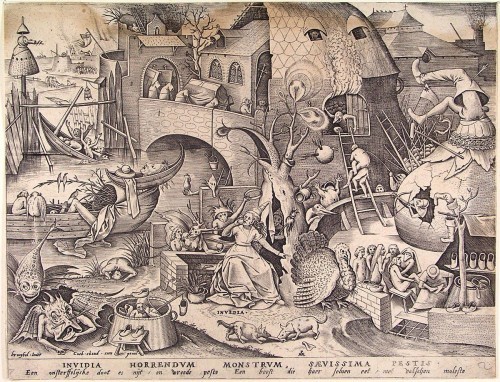
Envy from The Seven Deadly Sins, engraving by Pieter Bruegel the Elder in 1558
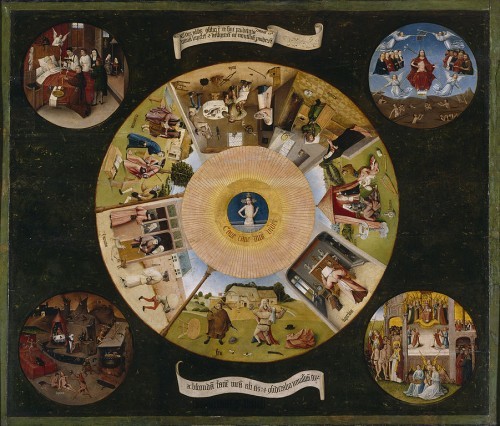
The Seven Deadly Sins and the Four Last Things, painting attributed to Hieronymus Bosch around 1500
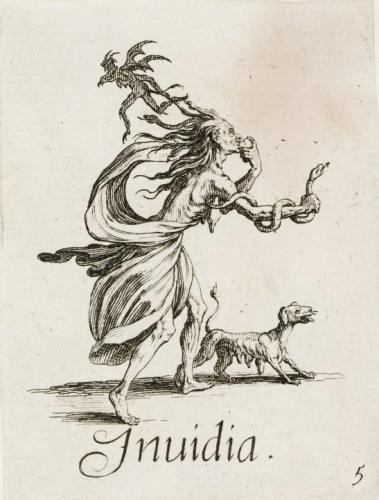
Envy from the series The Seven Deadly Sins, etching by Jacques Callot (1592-1635)
January 12, 2020
Reader, how does it fare with your family?
by Charles Spurgeon
Excerpt from The Treasury of David[image error]
I will be careful to lead a blameless life . . . I will walk in my house with a blameless heart. Psalm 101:2
Piety must begin at home. Our first duties are those within our own abode.
We must have a blameless heart at home, or we cannot keep a blameless way abroad.
Notice that these words are a part of a song. There is no music like the harmony of a gracious life, no psalm so sweet as the daily practice of holiness.
Reader, how does it fare with your family?
Do you sing in the choir, and sin in the chamber?
Are you a saint abroad, and a devil at home?
For shame!
What we are at home, that we are indeed!
He cannot be a true saint whose habitation is a scene of strife, and whose household dreads his appearance at the fireside.
Post may contain affiliate links to materials I recommend. Read my full disclosure statement.
January 11, 2020
Free 1849 Child’s Scripture Catechism
The Child’s Scripture Catechism
Originally written by H. M. Eaton in 1849
Edited by Harvey Bluedorn in 2001
158 questions for children are answered with Bible quotes. Questions cover such topics as: God, The Bible, Promises, Sin, Christ, Salvation, Duty Toward God, Duty Toward Men, Christian Conduct, Death and Resurrection.
Question #1. Who made us? . . . the Lord God formed man of the dust of the ground . . . Genesis 2:7
Question #29. How did sin enter into the world? . . . by one man sin entered into the world . . . Romans 5:12
Question #69. How many gods are there? . . . there is none other God but one. First Corinthians 8:4
Question #119. Will our prayers be answered if we continue in sin? If I regard iniquity in my heart, the Lord will not hear me. Psalm 66:18
Download The Child’s Scripture Catechism here

